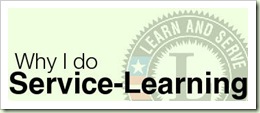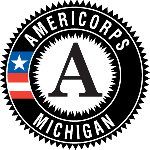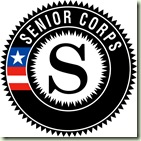By: Robyn Stegman, Learn and Serve – Michigan AmeriCorps*VISTA
“30 years ago, I never expected to like being called a blogger.”
- Nick Holton
The Guest Blogging program has been one of my favorite parts of my service here as the Learn and Serve – Michigan AmeriCorps*VISTA. I get to invite people to blog for us who have never blogged before. I get to share ideas and opinions from people all over the world of service-learning. Over the next few months we have blogs lined up from all over the United States. Blogs from youth innovators, involved parents, service-learning professionals, and leaders in the service field, not to mention blogs from the awesome service-learning practitioners we have right here in the state of Michigan.
I’m always looking for first time bloggers. We want you to share your stories, so I am pleased to announce that we will be starting a new blog series:
 Why I Do Service-Learning asks Michigan service-learning practitioners to tell their stories and dreams from the field. Over the next months we’ll share inspirational stories from across the state that provides an answer to the question: why engage in service-learning? To kick off this series I decided to share my own story of why I do service-learning.
Why I Do Service-Learning asks Michigan service-learning practitioners to tell their stories and dreams from the field. Over the next months we’ll share inspirational stories from across the state that provides an answer to the question: why engage in service-learning? To kick off this series I decided to share my own story of why I do service-learning.
Empowering Change: Why I Do Service-Learning.
When I was in the third grade my teacher asked us all to imagine that we were in medieval times. Each student received a piece of paper that told us what our role was to be. I was to be a serf and I quickly learned this was not a good thing. While the King and Queen got to snack on cupcakes, the serfs were given saltine crackers. While the lords and ladies could color with the brightest and most beautiful markers we were given yellow and brown crayons. We were told that in medieval times things were not fair, and on that my teacher and I agreed. So what does a third grader do in the face of medieval oppression? Strike.
That’s right. I got all of my fellow serfs together and we took construction paper and our yellow and brown crayons and made signs. We marched around the room through the sections of the classroom reserved for the upper crust, through our own imagined serf village, refusing to do our work until equality was restored. In the third grade I learned how to successfully lead a revolution.
Children are full with the energy and spirit that can change the world and they shouldn’t have to wait until they are 20 to do something about it. That day in the third grade I knew I wanted to change the world, even if it was an imaginary one. Imagine what my peers and I could have done in a service-learning classroom. What impact might we have had on the real world?
When I do site visits with Learn and Serve – Michigan grantees I see the same fire that ignited my third grade classroom. I see students, who by the fifth grade, have changed more lives then they can count. I meet middle school students who can speak more eloquently about homelessness then most adults. I meet kids who already, at the age of 10 or 17, have come up with a plan that will revolutionize the world, and it is because of their teachers and their classes.
Years later my third grade teacher still tells that story of the classroom strike. She once told me “That day I didn’t teach you, you taught me.” Now it is my turn to learn from students. Last month I was talking to fifth graders at the Detroit Service-Learning Academy about creating a community garden with them next year. One student raised his hand and asked, “Will we use organic seeds?” The truth was I hadn’t even thought about that. The students then engaged in a conversation about healthy recipes and ways they could use organically grown vegetables to make juice to replace the overly sugared juice beverages most kids drink. They were already making plans to change their community and we hadn’t even started the garden yet.
When I have a bad day at my service site, I think of those students and other students I have had the pleasure to meet. I think of their stories and accomplishments. Learn and Serve – Michigan students have contributed millions of hours of service to communities all over the state. They are transforming their community, becoming change makers, and leaders that are transforming the world today. That’s why I do service-learning: because kids are powerful forces for change and service-learning unleashes their potential.
Tell your story! Let us know why you do service-learning at http://www.surveymonkey.com/s/whyidosl.


